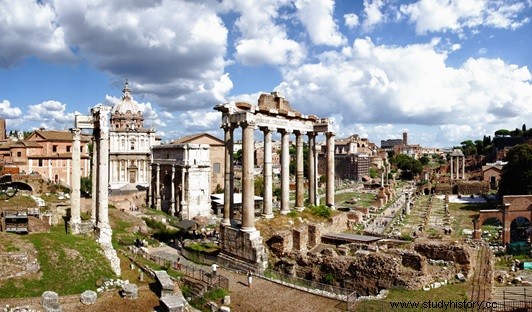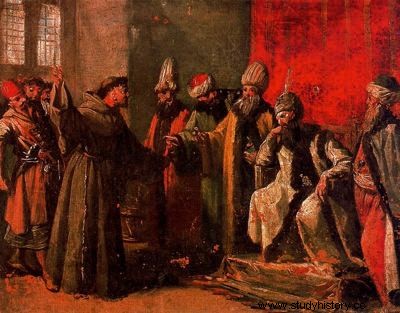 Few historians have been as criticized or praised for a single work as Toynbee. His Study of History , including the conception contained in its pages on the behavior of civilizations, was (and continues to be) criticized by those who consider it a pretentious and mistaken work and dismiss its conclusions as more typical of a Christian moralist than of a historian. There are, however, strong supporters of Toynbee who see in the English historian the continuation of the idea of history conceived by Spengler. Some and others agree in praising his erudition and deep knowledge of him.
Few historians have been as criticized or praised for a single work as Toynbee. His Study of History , including the conception contained in its pages on the behavior of civilizations, was (and continues to be) criticized by those who consider it a pretentious and mistaken work and dismiss its conclusions as more typical of a Christian moralist than of a historian. There are, however, strong supporters of Toynbee who see in the English historian the continuation of the idea of history conceived by Spengler. Some and others agree in praising his erudition and deep knowledge of him.
Arnold Toynbee was born in London on April 14, 1889. The first years of his life were spent in the small town of Winchester and later, in 1907, he attended Balliol College in Oxford, of which he would later be a fellow and tutor of ancient history between 1912 and 1915. Before beginning his teaching work, he traveled throughout Europe and the Near East during 1911 and 1912, familiarizing himself with the Greek archaeological sites and their culture.
Dysentery exempted him from enlisting in the English army to fight in the Great War, but during the war he worked for the Foreign Office's political intelligence department. He also participated in the peace conferences held in Paris, both at the end of the First and Second World Wars, as part of the English delegation.
After the end of the Great War he returned to teaching, but now at the University of London where he was professor of Greek and Byzantine language, literature and history from 1919 to 1924. In 1925 he was Appointed director of studies at the Royal Institute of International Affairs, a position he held until 1955, and soon after began editing the prestigious journal Survey of International Affairs . In parallel he continued as a research professor of international history at the University of London. He died on October 22, 1975.
Toynbee's historical production is quite prolific but has been overshadowed by his most important work, his Study of history . Composed of twelve volumes and written between the years 1934 to 1954, there are several anecdotes that revolve around the reason that led Toynbee to write it. According to one of them, it occurred to him while he was seeing some Bulgarian peasants with fox fur caps similar to those that Herodotus had already described when speaking of the clothing of the troops of the Persian king Xerxes. Whatever the reason that led him to write it, the truth is that his Study It is considered a classic of universal history. Among the rest of his works stand out Greek historical thought , The civilization and personality of the Greeks , Trial to Civilization , Approximation of a story to religion and From east to west; a trip around the world .
 Toynbee defends the cyclical theory of history and the “challenge/response” theory. Regarding the first, and unlike Spengler (from whom he receives a clear influence), he considers that it is not so much a closed circular development, but rather the application of certain descriptive laws, derived empirically from the comparative study of the phases that they have traveled through all civilizations, from their genesis to their decline.
Toynbee defends the cyclical theory of history and the “challenge/response” theory. Regarding the first, and unlike Spengler (from whom he receives a clear influence), he considers that it is not so much a closed circular development, but rather the application of certain descriptive laws, derived empirically from the comparative study of the phases that they have traveled through all civilizations, from their genesis to their decline.
Your idea of his story is thus more like a series of routes, in some cases parallel and in others diverging, than a circular path. This theory is completed with the one related to the “challenge/response” mechanism, that is, with the thesis that civilizations advance or stagnate and disappear depending on the response they are capable of giving to the challenges they face.
For Toynbee civilizations constitute the only intelligible historical field. They are the support of the historical movement and its basic unit of study. To understand the behavior of civilizations, the analysis must begin with their genesis, for which purpose they distinguish between two types of cultures:the primitive ones, which are static and remain clinging to the past without evolving, and the great, dynamic cultures, whose superiority is due to because at one point they knew how to respond creatively to a challenge.
 he distinguishes six types of primary cultures (Egyptian, Sumerian, Minoan, Chinese, Mayan and Andean) of which the remaining twenty-one civilizations that he identifies throughout humanity will be born. They are not closed, exclusive and excluding groups that have been happening in history, since there are connections between them and they are often related by hereditary ties. At the time he writes his work, he considers that only five survive:the European-Western Christian culture, the Orthodox Christian of Russian imprint, the Islamic, the Hindu and that of the Far East.
he distinguishes six types of primary cultures (Egyptian, Sumerian, Minoan, Chinese, Mayan and Andean) of which the remaining twenty-one civilizations that he identifies throughout humanity will be born. They are not closed, exclusive and excluding groups that have been happening in history, since there are connections between them and they are often related by hereditary ties. At the time he writes his work, he considers that only five survive:the European-Western Christian culture, the Orthodox Christian of Russian imprint, the Islamic, the Hindu and that of the Far East.
These twenty-one civilizations are conditioned by certain static and creative rhythms. The passage from one rhythm to another, that is, the ability to face the challenges that appear, does not depend on civilization itself, but on a select minority whose influence extends to the rest of society, by imitation or mimesis. But once this minority loses its capacity for creation and novelty and becomes dominant and static, the decline of society begins. The situation of collapse and disintegration arrives when the minority loses the loyalty of the majority and an internal decomposition of the civilization itself takes place. At this time, a turbulent period of social upheaval begins, led by an internal proletariat, in which the moral and social conditions of individuals are degraded. After a chaotic transit, a period of formation and development begins, which is preceded by another episode of turbulence in which a new minority manages to create a new civilization. This restarts the cycle.
Toynbee's company aims at a total vision of human history; in his visual field are the cultures of all continents. It is true that in the realm of the Near East, the ancient world, and European-American history he is equipped with better knowledge than in the realm of Indian, Chinese, and ancient American cultures. But his erudition is vast and his theory of universal history represents, as a scientific elaboration, the highest achievement that a single person has ever achieved in the field of history.
